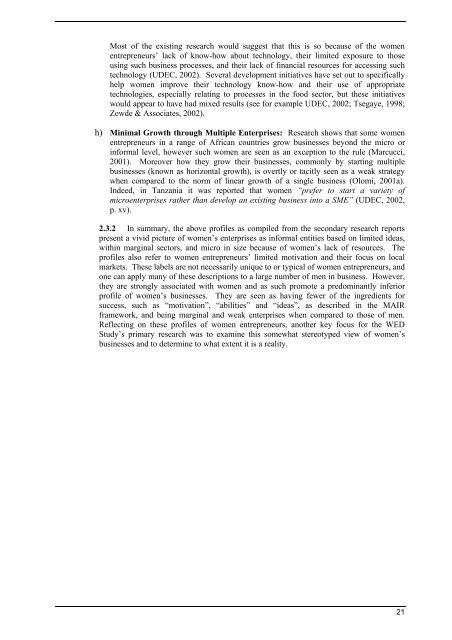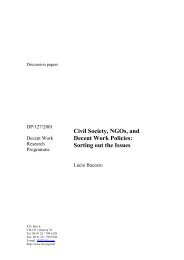The Challenges of Growing Small Businesses - International Labour ...
The Challenges of Growing Small Businesses - International Labour ...
The Challenges of Growing Small Businesses - International Labour ...
Create successful ePaper yourself
Turn your PDF publications into a flip-book with our unique Google optimized e-Paper software.
Most <strong>of</strong> the existing research would suggest that this is so because <strong>of</strong> the women<br />
entrepreneurs’ lack <strong>of</strong> know-how about technology, their limited exposure to those<br />
using such business processes, and their lack <strong>of</strong> financial resources for accessing such<br />
technology (UDEC, 2002). Several development initiatives have set out to specifically<br />
help women improve their technology know-how and their use <strong>of</strong> appropriate<br />
technologies, especially relating to processes in the food sector, but these initiatives<br />
would appear to have had mixed results (see for example UDEC, 2002; Tsegaye, 1998;<br />
Zewde & Associates, 2002).<br />
h) Minimal Growth through Multiple Enterprises: Research shows that some women<br />
entrepreneurs in a range <strong>of</strong> African countries grow businesses beyond the micro or<br />
informal level, however such women are seen as an exception to the rule (Marcucci,<br />
2001). Moreover how they grow their businesses, commonly by starting multiple<br />
businesses (known as horizontal growth), is overtly or tacitly seen as a weak strategy<br />
when compared to the norm <strong>of</strong> linear growth <strong>of</strong> a single business (Olomi, 2001a).<br />
Indeed, in Tanzania it was reported that women “prefer to start a variety <strong>of</strong><br />
microenterprises rather than develop an existing business into a SME” (UDEC, 2002,<br />
p. xv).<br />
2.3.2 In summary, the above pr<strong>of</strong>iles as compiled from the secondary research reports<br />
present a vivid picture <strong>of</strong> women’s enterprises as informal entities based on limited ideas,<br />
within marginal sectors, and micro in size because <strong>of</strong> women’s lack <strong>of</strong> resources. <strong>The</strong><br />
pr<strong>of</strong>iles also refer to women entrepreneurs’ limited motivation and their focus on local<br />
markets. <strong>The</strong>se labels are not necessarily unique to or typical <strong>of</strong> women entrepreneurs, and<br />
one can apply many <strong>of</strong> these descriptions to a large number <strong>of</strong> men in business. However,<br />
they are strongly associated with women and as such promote a predominantly inferior<br />
pr<strong>of</strong>ile <strong>of</strong> women’s businesses. <strong>The</strong>y are seen as having fewer <strong>of</strong> the ingredients for<br />
success, such as “motivation”, “abilities” and “ideas”, as described in the MAIR<br />
framework, and being marginal and weak enterprises when compared to those <strong>of</strong> men.<br />
Reflecting on these pr<strong>of</strong>iles <strong>of</strong> women entrepreneurs, another key focus for the WED<br />
Study’s primary research was to examine this somewhat stereotyped view <strong>of</strong> women’s<br />
businesses and to determine to what extent it is a reality.<br />
21
















